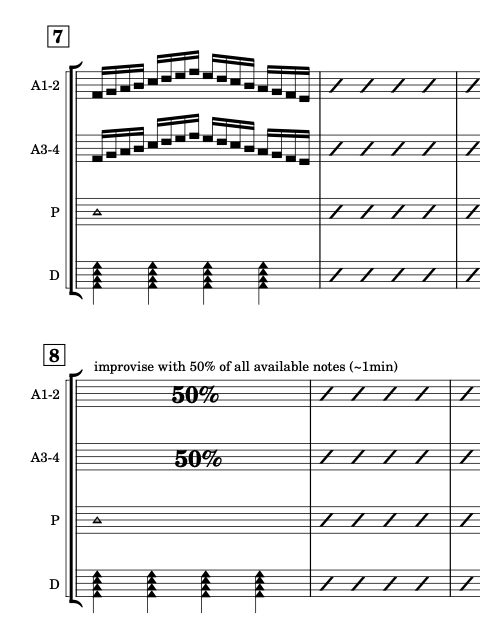I am at the age where I can make a “How It Started vs. How It’s Going” analysis of my music. Comparing performance practice change over a decade or so is valuable for my growth, especially when the piece involves improvisation and no score. I can see where I came from, where I am now, and where I should go next. Large Intestine for no-input mixer and computer premiered in 2013, and I still present it in concerts. Watching the August 2013 version and the recent June 2024 version in sequence gives me a chance to contemplate my electronic performance practice. Did the technology and style change over 11 years?
Technology
I took the “if it ain’t broke, don’t fix it” approach for Large Intestine in terms of the hardware and the software. The SuperCollider patch I coded 11 years ago is almost identical to the 2024 version. There were maintenance updates, such as replacing a deprecated UGen with a current one, but the signal-processing algorithm is untouched. The hardware signal flow is also unchanged, although I upgraded the mixer for increased possibility and flexibility.
I perform the piece by changing the mixer settings and SuperCollider patch. The SuperCollider patch consists of eight effect processors, and I turn on and off those effects in different combinations. It is much like playing a guitar with a pedal board. Over the past 11 years, I have bought a “new guitar” but am using the “same pedal.” The sonic possibilities remain the same, but how I play the instrument, the style in other words, has changed.
Download and run the SuerColider patch for Large Intestine as a reference. You can test it using a mic or any other instrument.
Style
I observed the following differences in the 2013 and 2024 versions of Large Intestine.
| 2013 | 2024 |
| Mostly slow and gradual parameter changes | Mostly fast and abrupt parameter changes |
| I discover things on stage | I present previously experienced sounds |
| The mixer supports computer sounds | The computer supports mixer sounds |
| Long duration (10+ minutes) | Short duration (less than 8 minutes) |
When I was a no-input beginner, I could not make quick transitions and variations. In the 2013 version, I treated the mixer as one of many sound sources that could pass through signal processors. Like its umbrella project, 100 Strange Sounds, Large Intestine featured my SuperCollider capacity. The 2024 version shows that I reduced the dependency on the computer part. I also learned to say more within less time.
Gained confidence also changed the performance goal. I make a one-sentence goal when I am improvising solo. My goal for Large Intestine used to be “Let me figure out what no-input mixer can do on stage,” as it delighted me to discover the mixer’s unique sound and its augmentation by the computer. 11 years later, there are much less delightful discoveries in the piece. But I can now expect the sound I can create. The current motto is, “Let me show you my favorite no-input mixer moments I learned previously on stage.”
Evaluation
I am my work’s biggest supporter and critic, but that does not help my career development. The audience ultimately decides the longevity of the work. Large Intestine was fortunate to be liked by the audience on many occasions. It received some honors, such as being included in the SEAMUS CD series (2015), a peer-reviewed annual album released by the Society for Electroacoustic Music in the United States. There were multiple invitations to perform at different venues, and it became an integral part of my solo performance practice. The positive feedback from presentations motivated me to delve further into the no-input mixer world. I composed the following pieces based on the learnings from Large Intestine.
- Gums for no-input mixer solo
- Snake and Ox for no-input mixer, computer, and a synth
- Func Step Mode for drum machine and no-input mixer
- Nim6tet for six no-input mixers
- No-input Singer for computer simulation of a no-input mixer
There are also clear limits to Large Intestine and my solo electroacoustic improvisation. I don’t expect other performers to play Large Intestine as it lacks score or instruction. The experience and joy I had with the piece are not transferable to other performers. This bothered me. I tackled this issue by teaching others how to play no-input mixers. I currently enjoy organizing no-input mixer workshops and no-input ensemble sessions. The mixer is a great introductory instrument for electronic music performance.


